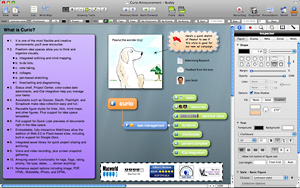 Zengobi Software recently launched version 5 of its Curio visual mapping and information management program for Mac OS X, which contains improvements to its mind mapping capabilities and a wealth of new project and information management tools.
Zengobi Software recently launched version 5 of its Curio visual mapping and information management program for Mac OS X, which contains improvements to its mind mapping capabilities and a wealth of new project and information management tools.
Before we get into the specifics about what’s new in this marvelous program, we need to tackle a few definitions. Everything will make more sense once you understand the terminology that Zengobi uses to describe Curio’s capabilities.
A project file can have multiple workspaces, called Idea Spaces in Curio parlance – quite literally, a canvas for your thoughts and ideas. This collection of Idea Spaces can be accessed via an vertical “organizer” pane on the left side of the workspace. Bracketing it on the right side of the workspace is the “inspector,” a set of tabbed dialog boxes where you can adjust the properties of individual items or assets within an Idea Space.
The basic building blocks of Curio Idea Spaces are mind maps, checklists and figures. Mind maps have been enhanced in version 5 to enable you to expand and contract map branches, as well as a way to view your mind map as an outline. Individual map topics can have task data attached to them; Curio 5 automatically “rolls up” changes to start and end dates of parent topics if you change the duration of a child topic – nice!
Inidivual items, called figures, can be added to an Idea Space, and then later joined together by connector lines – something like a concept map. As you move items around the workspace, these connectors adjust their shape and direction automatically.
 One of the biggest additions to Curio 5 is robust project management tools. You can track hundreds of separate tasks, and quickly scan those that currently need attention using a new “status” module (see image at right) that gives you a color-coded visual indication of their status. You can also “tag” tasks to categorize them, using a set of ready-made tags (which include Getting Things Done tags!) or by adding your own custom tags. Tasks and events can also be synchronized with iCal.
One of the biggest additions to Curio 5 is robust project management tools. You can track hundreds of separate tasks, and quickly scan those that currently need attention using a new “status” module (see image at right) that gives you a color-coded visual indication of their status. You can also “tag” tasks to categorize them, using a set of ready-made tags (which include Getting Things Done tags!) or by adding your own custom tags. Tasks and events can also be synchronized with iCal.
In addition, you can create web page links within an IdeaSpace using Curio 5’s new WebView Figure. A preview of the web page is displayed along with the link. When clicked, it becomes a live view of the web page – nice!
Finally, Curio 5 contains a “Scrapbook Shelf,” where you can save commonly-used assets for future use.
This summary only scratches the surface of what Curio 5 can do. Check out the what’s new page on the Zengobi website for more details. I’ve watched this product develop for several years, when it was primarily as a mind mapping tool for the Mac. But now it has evolved into a full-fledged digital notebook and project management tool that you can use to capture and manage a wealth of information, ideas and knowledge.

Leave a Reply